| Srl | Item |
| 1 |
ID:
130661
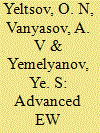

|
|
|
|
|
| Publication |
2014.
|
| Summary/Abstract |
The article discusses advanced reconnaissance and weapon guidance radars as potential targets of electronic warfare. Also discussed are the role and significance of reconnaissance and weapon guidance radar systems in combat operations, and general trends toward greater information gathering capabilities of radar systems. It also presents the multiple input-multiple output (MIMO) multichannel radar system, and the effectiveness and survival rate of radar systems using MIMO technologies.
|
|
|
|
|
|
|
|
|
|
|
|
|
|
|
|
| 2 |
ID:
130046


|
|
|
|
|
| Publication |
2014.
|
| Summary/Abstract |
At the beginning of the space age, the United States relied upon the general acceptance of a sanctuary narrative of outer space in order to help support its reconnaissance activities over the Soviet Union. The notion that space could be a sanctuary thus served as a diplomatic tactic, one designed to thwart Soviet opposition to American overflight. While the Soviets eventually achieved parity-having later acquired the ability to surveil the United States-the notion of sanctuary became untenable once the Soviet Union began to further leverage space power for the aim of attacking American satellites and naval assets. The crucial moment, as revealed in recently declassified documents, occurred in 1976 when the Ford Administration recognized the need for an American anti-satellite capability. Subsequently, while the Carter Administration appeared to pursue comprehensive space arms control, what was really in play was a gambit, one designed to eliminate the Soviet's co-orbital anti-satellite capability and maintain strategic parity in space.
|
|
|
|
|
|
|
|
|
|
|
|
|
|
|
|
| 3 |
ID:
111259
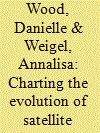

|
|
|
|
|
| Publication |
2012.
|
| Summary/Abstract |
This paper analyzes the historical paths of eight countries - from Africa, Asia and Latin America - as they have pursued technological capability in the area of space technology. The analysis is unfolded in three stages. The first stage introduces a framework called the Space Technology Ladder. This Ladder framework posits a path through four major technology categories, as follows: 1) establishing a national space agency; 2) owning and operating a satellite in low Earth orbit; 3) owning and operating a satellite in geostationary orbit; and 4) launching satellites. The second stage of the analysis uses data to create a graphical timeline, by mapping the historical achievements of the eight countries onto the Ladder framework. The results provide information about the similarities and differences in the technology strategies of the various countries. The third stage is a discussion of the strategic decisions faced by the countries under study. Exploring their diverse strategies is an initial step toward developing prescriptive theory to inform developing country space programs.
|
|
|
|
|
|
|
|
|
|
|
|
|
|
|
|
| 4 |
ID:
135526
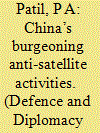

|
|
|
|
|
| Summary/Abstract |
Employment of space technology in the first gulf war led Chinese defence analysts to recognize the significance and effect of space control in contemporary warfare. while the United States is the leader in the space arena, the importance of space for inclusive growth has been gauged the world over by space-faring nations as well as space aspiring ones. Some of these nations, with china as a frontrunner, have made credible advances to pose a challenge to US hegemony in space.
|
|
|
|
|
|
|
|
|
|
|
|
|
|
|
|
| 5 |
ID:
056438
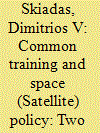

|
|
|
| 6 |
ID:
179854
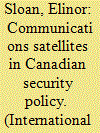

|
|
|
|
|
| Summary/Abstract |
This article traces Canada’s early interest in space, before turning to its late 1960s decision to focus on a domestic, commercial/civilian communications satellite system in geostationary orbit and the subsequent decline in Canada’s military space efforts. It then highlights the wake-up call of the 1991 Gulf War, which demonstrated the critical importance of military communications satellites to future operations, and the steps Canada has taken to gain assured access to such satellites in the decades since. The final section outlines recent advances in low Earth orbit satellite communications (LEO satcom) and the ways in which these systems can address shortfalls in their geostationary cousins. Drawing reference to a new international security environment, it concludes that Canada should move expeditiously to incorporate LEO satcom into efforts to address the growing imperative of military satellite communications in the Canadian Arctic.
|
|
|
|
|
|
|
|
|
|
|
|
|
|
|
|
| 7 |
ID:
010646
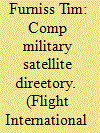

|
|
|
|
|
| Publication |
June 5-11, 1996.
|
| Description |
29-35
|
|
|
|
|
|
|
|
|
|
|
|
|
|
|
|
| 8 |
ID:
062956
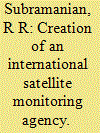

|
|
|
| 9 |
ID:
069300
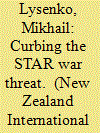

|
|
|
| 10 |
ID:
061946
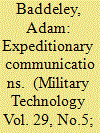

|
|
|
| 11 |
ID:
021334
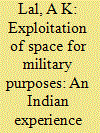

|
|
|
|
|
| Publication |
Jan-March 2002.
|
| Description |
62-70
|
|
|
|
|
|
|
|
|
|
|
|
|
|
|
|
| 12 |
ID:
130998
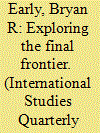

|
|
|
|
|
| Publication |
2014.
|
| Summary/Abstract |
While space capabilities were once concentrated among a handful of leading powers, an increasingly large number of states have gained access to them. As of 2007, 58 countries possessed dedicated civil space programs, 44 countries had placed nationally owned satellites into orbit, and 9 countries had achieved domestic space launch capabilities. To date, however, no systematic inquiries have ever been conducted into which countries acquire space capabilities and why. Within this paper, I develop an explanatory account that explores the capacity-based factors and political motivations that influence countries' acquisition of space capabilities. I test my hypotheses via a quantitative analysis of the factors affecting 143 countries' acquisition of civil space programs, satellite capabilities, and space launch capabilities from 1950 to 2002. My findings shed new light on the primary causes of the proliferation of civil space capabilities and yield a number of important policy implications
|
|
|
|
|
|
|
|
|
|
|
|
|
|
|
|
| 13 |
ID:
131038
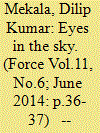

|
|
|
|
|
| Publication |
2014.
|
| Summary/Abstract |
In August 2013, India successfully launched its latest dedicated defence satellite GSAT-7. Planned to serve as an exclusive defence satellite for the Indian Navy, the satellite, as Indian Space Research Organisation (ISRO), boasted of its safety and reliable communication. Although ISRO, which is popularly seen as a civilian space agency, could not openly accept the defence usage of this satellite, analysts claim that this satellite will serve as a force multiplier and help navy in networking all its warships, submarines and aircrafts with its ground based assets. The satellite will help the Indian Navy strengthen its blue water combat capabilities. This advanced multi-band communication satellite was launched by Ariane-5 launch vehicle of Arianespace from Kourou, French Guiana.
|
|
|
|
|
|
|
|
|
|
|
|
|
|
|
|
| 14 |
ID:
107880
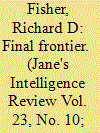

|
|
|
| 15 |
ID:
064769
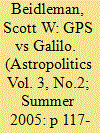

|
|
|
| 16 |
ID:
130676


|
|
|
|
|
| Publication |
2014.
|
| Summary/Abstract |
The article discusses procedures for identifying the type and nationality of aerial vehicles to enhance effectiveness of airspace control during conflict situations. Capabilities of optoelectronic devices to gather information on class and type of aircraft are discussed. Images from a combination of optical detection instruments and radar obtained through experimental observations are presented to illustrate improvements possible to the image quality.
|
|
|
|
|
|
|
|
|
|
|
|
|
|
|
|
| 17 |
ID:
157159
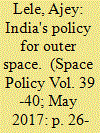

|
|
|
|
|
| Summary/Abstract |
This article discusses the basic philosophy behind India's space strategy based on ideological, sociological, political, economic, geostrategic and legal constructs. The paper uses the metaphor of “deconstruction” made famous by the French philosopher Jacques Derrida's (1930–2004) to understand various transitions (if any) in India's space policy over the years and the philosophy behind them. The paper follows a ‘narrative based scrutiny’ approach to recognise Indian attitude for investments into space technologies.
|
|
|
|
|
|
|
|
|
|
|
|
|
|
|
|
| 18 |
ID:
132564


|
|
|
|
|
| Publication |
2014.
|
| Summary/Abstract |
Low earth orbit has become increasingly congested as the satellite population has grown over the past few decades, making orbital debris a major concern for the operational stability of space assets. This congestion was highlighted by the collision of the Iridium 33 and Cosmos 2251 satellites in 2009. This paper addresses the current state of orbital debris regulation in the United States and asks what might be done through policy change to mitigate risks in the orbital debris environment. A brief discussion of the nature of orbital debris addresses the major contributing factors including size classes, locations of population concentrations, projected satellite populations, and current challenges presented in using post-mission active debris removal to mitigate orbital debris. An overview of the current orbital debris regulatory structure of the United States reveals the fragmented nature of having six regulating bodies providing varying levels of oversight to their markets. A closer look into the regulatory policy of these agencies shows that, while they all take direction from The U.S. Government Orbital Debris Mitigation Standard Practices, this policy is a guideline with no real penalty for non-compliance. Various policy solutions to the orbital debris problem are presented, ranging from a business as usual approach to a consolidated regulation system which would encourage spacecraft operator compliance. The positive aspects of these options are presented as themes that would comprise an effective policy shift towards successful LEO conservation. Potential economic and physical limitations to this policy approach are also addressed.
|
|
|
|
|
|
|
|
|
|
|
|
|
|
|
|
| 19 |
ID:
130043
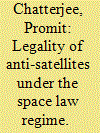

|
|
|
|
|
| Publication |
2014.
|
| Summary/Abstract |
The term anti-satellite, or in short ASAT, is used to refer to a system designed to destroy or damage satellites. The heightened tendency among the spacefaring nations to develop ASAT technology in the recent past has led to widespread debates as to the legality of ASAT deployment under the space law regime. In this context, I have endeavored to make a detailed analysis of the international legal provisions to find if there is any legal basis at all for the deployment of such ASATs. I have concluded that none of the existing legal provisions in space law, as well as public international law, have sufficient force and clarity to bring about a blanket ban on ASAT weapons. Therefore, the research suggests a slew of reforms to overcome this anomaly. Examples of such proposed reforms include, inter alia, an amendment of the Outer Space Treaty and an enhanced role and influence of the United Nations in treaty making coupled with active diplomatic initiatives.
|
|
|
|
|
|
|
|
|
|
|
|
|
|
|
|
| 20 |
ID:
019246
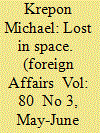

|
|
|
|
|
| Publication |
May-June 2001.
|
| Description |
2-8
|
|
|
|
|
|
|
|
|
|
|
|
|
|
|
|